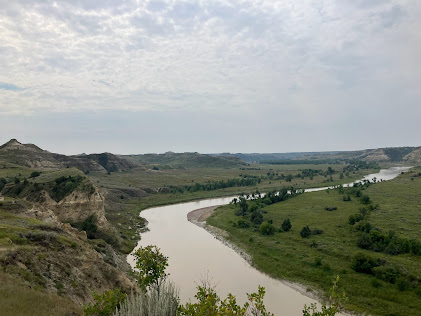Our plan for the day was to drive through Theodore Roosevelt National Park on the 36-mile Scenic Loop Drive, and we stopped at the Visitors Center first. I should mention that this was one of many National Parks where we gained free admission, rather than the usual $35.00 entrance fee, because I had had the foresight to purchase one of these lifetime Senior Passes many, many years ago (when I first became a senior). Lifetime cards are no longer issued, only annual passes. “Hang on to that!” one ranger told us. “It’s solid gold!” We estimate that the card saved us close to $500 in entrance fees throughout our road trip.
I had not realized before visiting this National Park what a conservationist Theodore Roosevelt was. He is in fact often referred to as the first conservationist president, using his authority to protect wildlife and public lands by creating the United States Forest Service and establishing 150 national forests, 51 federal bird reserves, 4 national game preserves, 5 national parks, and 18 national monuments. “We have fallen heirs to the most glorious heritage a people ever received,” he once said, “And each one must do his part if we wish to show that the nation is worthy of its good fortune."
The park was very beautiful, with its backdrop of tall mesas all around. There was a replica of the log cabin where Roosevelt stayed, and as was true in all of our experiences in these National Parks, the Visitors Center was educational and the rangers were invariably informative. “Have you seen any wildlife?” I asked, and a ranger told me that a bison had visited earlier in the morning.
We saw plenty of wildlife along the loop,
including prairie dogs, wild horses, and bison, and we stopped frequently to
take short hikes along the loop road.
A particularly nice hike was up the Wind Canyon Trail to a vista overlooking the Little Missouri River.
When we returned, we realized that we had plenty
of time to visit the Chateau de Mores.
This 26-room two-story frame building was built in 1883
as the summer residence of the Marquis de Mores in 1883. The French immigrant was a famous rancher and
notorious gunslinger, and his wife Medora gave this place its name. It was a well-preserved home with many of the
original furnishings.
We also had time to visit the Cowboy Hall of
Fame before dinner at a little place we had discovered earlier called Medora Uncorked. We learned how
Native Americans had hunted these huge bison on horseback with bow and arrow,
and seeing exhibits of these creatures and the comparative size of the ponies
used in the hunt made us appreciate even more what an incredible feat it was to
take them down. Before returning to the
Rough Riders Hotel for our last night, we spent some time listening to some
folk music at the Town Square played by an unassuming young man who was a very good guitarist and was also very knowledgeable about the music he played. It was a wonderful evening, with a cool breeze blowing across the square and an appreciative audience.


.jpg)
.jpg)
.jpg)
.jpg)
.jpg)

.jpg)


No comments:
Post a Comment